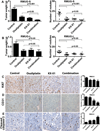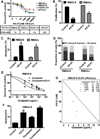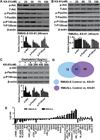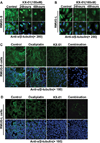Targeting SRC and tubulin in mucinous ovarian carcinoma
- PMID: 24100628
- PMCID: PMC3852199
- DOI: 10.1158/1078-0432.CCR-13-1305
Targeting SRC and tubulin in mucinous ovarian carcinoma
Abstract
Purpose: To investigate the antitumor effects of targeting Src and tubulin in mucinous ovarian carcinoma.
Experimental design: The in vitro and in vivo effects and molecular mechanisms of KX-01, which inhibits Src pathway and tubulin polymerization, were examined in mucinous ovarian cancer models.
Results: In vitro studies using RMUG-S and RMUG-L cell lines showed that KX-01 inhibited cell proliferation, induced apoptosis, arrested the cell cycle at the G2-M phase, and enhanced the cytotoxicity of oxaliplatin in the KX-01-sensitive cell line, RMUG-S. In vivo studies showed that KX-01 significantly decreased tumor burden in RMUG-S and RMUG-L mouse models relative to untreated controls, and the effects were greater when KX-01 was combined with oxaliplatin. KX-01 alone and in combination with oxaliplatin significantly inhibited tumor growth by reducing cell proliferation and inducing apoptosis in vivo. PTEN knock-in experiments in RMUG-L cells showed improved response to KX-01. Reverse phase protein array analysis showed that in addition to blocking downstream molecules of Src family kinases, KX-01 also activated acute stress-inducing molecules.
Conclusion: Our results showed that targeting both the Src pathway and tubulin with KX-01 significantly inhibited tumor growth in preclinical mucinous ovarian cancer models, suggesting that this may be a promising therapeutic approach for patients with mucinous ovarian carcinoma.
©2013 AACR.
Conflict of interest statement
Figures





References
-
- Hess V, A'Hern R, Nasiri N, King DM, Blake PR, Barton DP, et al. Mucinous epithelial ovarian cancer: a separate entity requiring specific treatment. J Clin Oncol. 2004;22:1040–1044. - PubMed
-
- Pectasides D, Fountzilas G, Aravantinos G, Kalofonos HP, Efstathiou E, Salamalekis E, et al. Advanced stage mucinous epithelial ovarian cancer: the Hellenic Cooperative Oncology Group experience. Gynecol Oncol. 2005;97:436–441. - PubMed
-
- Pisano C, Greggi S, Tambaro R, Losito S, Iodice F, Di Maio M, et al. Activity of chemotherapy in mucinous epithelial ovarian cancer: a retrospective study. Anticancer Res. 2005;25:3501–3505. - PubMed
-
- Bamias A, Psaltopoulou T, Sotiropoulou M, Haidopoulos D, Lianos E, Bournakis E, et al. Mucinous but not clear cell histology is associated with inferior survival in patients with advanced stage ovarian carcinoma treated with platinum-paclitaxel chemotherapy. Cancer. 2010;116:1462–1468. - PubMed
Publication types
MeSH terms
Substances
Grants and funding
- P30 CA016672/CA/NCI NIH HHS/United States
- P50CA098258/CA/NCI NIH HHS/United States
- CA16672/CA/NCI NIH HHS/United States
- R01 CA109298/CA/NCI NIH HHS/United States
- P50 CA098258/CA/NCI NIH HHS/United States
- U54 CA151668/CA/NCI NIH HHS/United States
- CA098258/CA/NCI NIH HHS/United States
- P50 CA083639/CA/NCI NIH HHS/United States
- R01 CA128797/CA/NCI NIH HHS/United States
- T32 CA009666/CA/NCI NIH HHS/United States
- UL1 TR000371/TR/NCATS NIH HHS/United States
- T32 CA101642/CA/NCI NIH HHS/United States
- CA128797/CA/NCI NIH HHS/United States
LinkOut - more resources
Full Text Sources
Other Literature Sources
Medical
Research Materials
Miscellaneous

